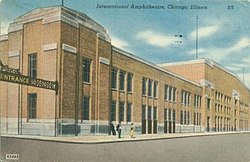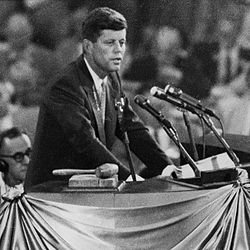Sports
Televised boxing and wrestling events were held at the venue for decades, making it a well-known venue across the United States. [5] In December 1981, Joe Frazier had his final boxing match at the Amphitheatre against Floyd Cummings, which resulted in a draw.
The arena, which seated 9,000 for sports events, was the first home of the Chicago Packers of the NBA during 1961–62, before changing their name to the Chicago Zephyrs and moving to the Chicago Coliseum for their second season. [10] It was also the home of the Chicago Bulls during their inaugural season of 1966–67. The team played one time in the Chicago Coliseum, a playoff game in their first season, as no other arena was available for a date with the St. Louis Hawks. The Bulls then moved permanently to Chicago Stadium, where they remained until 1994, when they moved to their current home at the United Center.
The Amphitheatre was also the primary home of the Chicago Cougars of the WHA from 1972 to 1975. It was originally intended to be only a temporary home for the Cougars, but the permanent solution, the Rosemont Horizon, was not completed until 1980, five years after the team folded and a year after the WHA ceased operation. The International Amphitheatre was the home for Chicago's wrestling scene for years as well as the Chicago Auto Show for approximately 20 years beginning in the 1940s. [11] [8]
Strangely enough, on December 30, 1962, and January 5, 1964, the Chicago Amphitheatre hosted The Southside WinterNationals INDOOR Drag Races. With the smooth concrete floors, Drivers reported it was like racing on ice. It was also reported that after the first races, cases of Coca-Cola syrup were brought in, poured on the floor and allowed to dry overnight. Drivers like Arnie "The Farmer" Beswick, and Mr. Norm from Grand Spaulding Dodge later admitted the syrup did little to help traction. Staging was outside in the Chicago - January cold. Drivers did as many as 5 "burnouts" just to heat the rear tires. The shutdown area involved a sharp turn and wall that claimed more than a few of the entries.
On March 13–14, 1976, the Midwest Regional of the North American Soccer League's 1976 Indoor tournament was hosted by the Chicago Sting at the Amphitheater. The Rochester Lancers won the Region to advance to the Final Four played in Florida. [12]
The Loyola Ramblers basketball team were tenants of the venue during their 1987–88 and 1988–89 seasons, [5] [7] but faced poor attendance at the aging facility. [7]
The Amphitheatre hosted the Chicago Public League boys basketball semifinals and finals intermittently from the 1950s through 1990s. [13] The 1991 CPL tournament at the Ampitheatre, won by Marshall High School, was featured in the documentary film Hoop Dreams .
Concerts and entertainment
Notable performers who held shows at the venue included Dale Evans and Roy Rogers, Evel Knievel, The Rolling Stones, Frank Sinatra, Led Zeppelin, The Who, Pink Floyd, AC/DC, Black Sabbath, Rush, Santana, Ike & Tina Turner, Grateful Dead, Van Halen, Aerosmith, UFO, Selena and The Jackson 5. [5] [14] The Amphitheatre is noted for being the site of one of Elvis Presley’s most notable concerts, on March 28, 1957, with the singer wearing his now legendary gold lamé suit for the first time. [15] On September 5, 1964, and August 12, 1966, The Beatles performed at the Amphitheatre. The 1966 show was the first show of what proved to be their last tour. [16] For eighteen years, the arena was the site of Chicago visits by the Ringling Brothers and Barnum & Bailey Circus. [5] In October 1978, English rock group UFO recorded parts of what would become Strangers in the Night at the International Amphitheatre.







